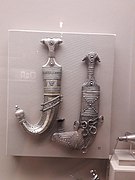Benaki Museum
The Benaki Museum is a museum in Athens, Greece, near Syntagma Square, founded in 1931 by a wealthy Athenian, Egyptian-born Antonios Benakis, in honor of his father Emmanuel Benakis. It houses a sumptuous collection of art, from Mycenaean works to Greek icons.
The collection of this museum began in Alexandria with Islamic art, continued with Byzantine art and finally, once settled in Greece, it was completed with pieces of autochthonous art.
The main venue is distributed in some forty rooms that have more than 40,000 works that cover a fairly wide period, from the ancient Greek civilizations, the Roman occupation, the Byzantine period, the post-Byzantine period, the occupation and conquest by part of other European countries and their independence, as well as a complete display of the vision and evolution of Greek art through the ages.
The Kozani room stands out, reproducing a living room from the 18th century.
It also has a modern restoration workshop and a library of more than 180,000 volumes.
Collections
The collections belonging to this museum are divided into several buildings according to their theme:
- The museum of Greek culture is based in the main building, which is neoclassical in style and is located near the building of the Greek parliament. It exposes the evolution of Greek culture from prehistory to the centuryXX., through pieces that can be divided into:
-Prehistoric art: It consists of numerous pieces from prehistory to the end of the Roman era.
-Byzantine art: The first part of the collection includes miniature crafts, bronze and silver items for religious or everyday use, small sculptures, ceramics and manuscripts. The second part is made up of Byzantine and post-Byzantine icons and works of art from Mount Athos until the appearance of Neo-Greek painting. In addition, it includes censers and chalices, mitres, and Byzantine jewelry such as sapphires, amethysts, emeralds, and pearls.
-Post-Byzantine and modern art: Collection of pieces belonging to a chronology between the 15th and 19th centuries, in which Greece was under Ottoman and Frankish rule.
|
- The Islamic art museum is located in a building near the archaeological site of the ceramic. It opened in 2004. It contains Islamic art objects whose origin was the collection that Antonios Benaki gathered during his stay in Egypt and subsequently enriched by donations. It consists of more than 12 000 pieces of ceramic, glass, wood, goldsmithy, textiles, weapons and tombstones with inscriptions that allow to expose the evolution of Islamic art from its origins to the centuryXIX.
|
- The toy museum is located in the "Kulura House". It is composed mainly of a collection gathered by Maria Argyriadis consisting of about 20 000 objects—plays, books, clothing and other children’s objects—of periods ranging from Antiquity to the century.XX..
- The Valadoros collection, composed of about 300 religious pieces from Antiquity to the post-Byzantine period, is, in part, exposed in the old family house that donated this collection. One of the main objects of this collection is an epitaph embroidered in gold of the centuryXIV which, however, is exhibited among the works of the exhibition of Greek culture.
- The gallery Gikas, dedicated to the painter Nikos Jatzikyriakos-Gikas, houses works belonging to this century painterXX.. Its headquarters is a building built in 1932 that belonged to the painter's family and was donated to the museum by the artist.
- The Benaki Museum Cultural Centre is located in a building on El Pireo Street. It organizes multiple cultural activities and also hosts a archive of artistic photographs and a collection of documents related to the neo-Hellenic architecture that has been developed since the independence of Greece in 1828 to the present day.
- The historical archives department of the Benaki Museum and another collection of archives related to the performing arts are located in the house of the writer Penélope Delta, a building early in the centuryXX. located in the municipality of Kifisia.
- The home of Patrick Leigh Fermor and his wife Joan, in the Mani region, includes accommodation for researchers and organizes educational and cultural activities.
In addition, this museum has collections of Coptic art, pre-Columbian art, Chinese and Korean art, and sculptures by Giannis Pappas.
Contenido relacionado
35
1659
Prince Edward Island





